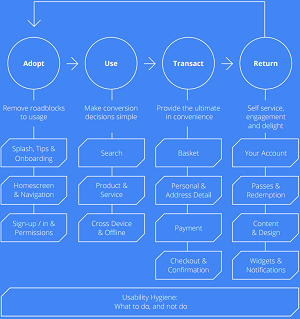News
Google Offers Mobile App UX Tips for More Conversions
- By David Ramel
- April 29, 2015
In the two-horse race for mobile app store supremacy, Google's Play Store consistently ranks behind Apple's App Store in monetization opportunities. Perhaps to help close that gap, the search giant has published a guide to increase conversions via best-practice UX tips.
The conventional thinking goes like this: Google may have more apps, but many are cheap or free and developers don't earn as much coding for Android, while iOS devices -- more expensive, targeting a higher-end clientele -- lend themselves to higher payoffs for developers.
Google published an extensive Mobile App UX Principles guide to improve app UX and boost money-generating capabilities, and perhaps help Android devs catch up to their iOS brethren, though the guide includes tips relevant to both platforms.
"The objective of this study is to help companies improve/optimize conversion of their existing apps that are focused on sales, bookings, etc.," wrote author Stephen Griffiths in the guide published last week. Rather than being based on usability studies, the report is based on UX best practices as gleaned from auditing apps, published Android and iOS guidelines, secondary research and other sources.
 [Click on image for larger view.]
Improving the UX Cycle (source: Google)
[Click on image for larger view.]
Improving the UX Cycle (source: Google)
The 49-page guide is divided into sections for removing roadblocks to adoption and usage of an app, making conversion decisions simple, providing convenient transactions, encouraging return visits through self-service, engagement and an enjoyable experience, and a "Usability Hygiene" section featuring "what to do, and NOT to do."
Under the latter, for example, are dozens of tips concerning everything from text font choices to non-connected scenarios to transitions.
For example, here's a tip to not take users to the device (the guide is for smartphones only, not tablets) browser:
"Do not take users to the browser (users stay in-app at all times). Keep users in-app at all times, to maintain their geography and to optimize conversion. If your app lacks a specific feature or content, try to use an in-app browser; but do not invoke the smartphone browser, or you will cause users to lose their geography and not return to the app, which will increase abandonment and reduce conversion."
Google said that although the guide does contain tips that could help in the creation of new apps, it's designed to help developers optimize their existing apps.
"It defines the key principles and considerations -- i.e. the important things to think about -- when assessing smartphone apps, in order to identify what and how to improve the UX, optimize conversion and better measure app performance," the guide states.
The guide is the latest example of Google's emphasis on mobility, as just last week it changed an algorithm to place more importance on site "mobile-friendliness" in ranking mobile search results.
About the Author
David Ramel is an editor and writer at Converge 360.